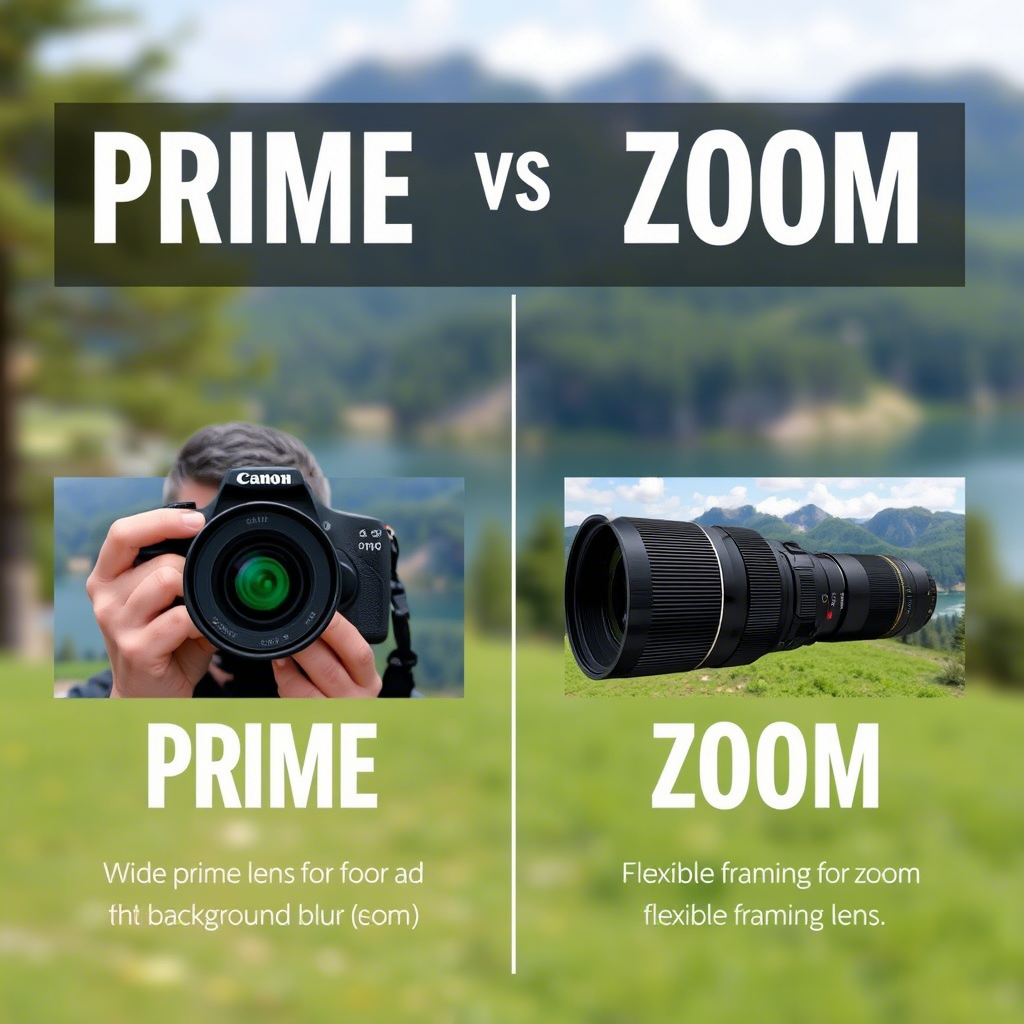If you’ve ever browsed camera lenses online or walked into a camera store, you’ve probably faced this confusing choice: prime lens or zoom lens? And like many beginners (myself included when I started), you might be wondering: “What’s the actual difference?” or “Does it even matter for my type of photography?”
In this article, I’ll walk you through the key differences between prime and zoom lenses, without the jargon overload. Whether you’re a casual shooter, portrait lover, or future wedding photographer, this guide will help you choose the right tool for your creative vision.
What Is a Prime Lens?
A prime lens has a fixed focal length, meaning it doesn’t zoom in or out. For example, a 50mm prime lens stays at 50mm. Want to get closer to your subject? You’ll need to physically move.
Why Photographers Love Prime Lenses:
- Sharper images: Fewer glass elements = more clarity and contrast.
- Wider apertures: f/1.4 or f/1.8 gives you that delicious background blur (bokeh).
- Great in low light: Perfect for indoor, wedding, or night shooting.
- Lightweight and compact: Easier to carry during long shoots.
Real Example: I once shot an entire portrait session with just a 35mm f/1.4 prime. The crispness and soft bokeh made the images feel almost cinematic—even on a cloudy day.
What Is a Zoom Lens?
A zoom lens lets you adjust your focal length within a range—like 24-70mm or 70-200mm. You can zoom in and out without changing your position.
Why Zoom Lenses Are So Popular:
- Versatile: One lens covers multiple scenarios—wide shots, close-ups, and everything in between.
- Convenient for events: Great for weddings, sports, or travel where you can’t get closer.
- Fewer lens changes: Reduces the chance of dust entering your sensor.
- Modern zooms are sharp too: Today’s pro zooms (like f/2.8 constant aperture models) are top-tier.
Real Example: During a client’s outdoor ceremony, I used a 24-70mm f/2.8 lens. I could capture wide shots of the venue and then instantly zoom in for emotional close-ups—all without switching lenses.
Prime vs Zoom Lens: Quick Comparison Table
| Feature | Prime Lens | Zoom Lens |
| Focal Length | Fixed (e.g. 50mm) | Variable (e.g. 24–70mm) |
| Image Quality | Generally sharper | Slightly less sharp (but improving) |
| Low Light Performance | Excellent (f/1.2–f/1.8) | Good (typically f/2.8 or f/4) |
| Bokeh | Creamier due to wider aperture | Still possible, but more limited |
| Flexibility | Limited – move physically | Highly flexible |
| Weight | Lighter and smaller | Heavier and bulkier |
| Price | Affordable options available | Often more expensive |
Which One Should You Choose?
Choose a Prime Lens if:
- You want the sharpest image quality and stunning bokeh.
- You often shoot portraits, street, or low-light scenes.
- You like to move with your feet and shoot more intentionally.
Tip: A 50mm f/1.8 lens is often called the “nifty fifty” for a reason—it’s affordable, light, and produces professional results.
Also Read:
Best Lens for Portraits with Bokeh Effect – Expert Picks & Real-World Insights
Nikon vs Canon for Beginners: Which One’s Right for You?
Choose a Zoom Lens if:
- You shoot events, travel, or wildlife, where movement is tricky.
- You need flexibility and fewer lens changes.
- You want all-in-one convenience (e.g. 24–105mm for daily use).
Tip: Invest in a good zoom like a 24–70mm f/2.8 if you’re shooting weddings or client work—it’ll be your workhorse.
FAQs
Q: Is a prime lens better than a zoom?
A: Not necessarily. Prime lenses are sharper and better in low light, but zooms offer flexibility. It depends on your shooting style.
Q: Can I just use one type of lens?
A: Absolutely. Many photographers use a single 35mm or 50mm prime for years. Others carry just a zoom. It’s about what works for you.
Q: Are primes more expensive?
A: Some are, but great budget options exist. A Canon 50mm f/1.8 or Nikon Z 40mm f/2 are under $200 and punch way above their weight.
Final Thoughts: The Real Difference Comes Down to You
At the end of the day, the difference between prime and zoom lenses isn’t just about specs—it’s about how you shoot. A zoom might offer the freedom to frame things from a distance, while a prime makes you pause, think, and compose more intentionally.
If you’re just starting out, try both. Rent a lens. Borrow from a friend. Or start with a budget, prime to explore your style.

1 thought on “Difference Between Prime and Zoom Lens – A Photographer’s Honest Breakdown”